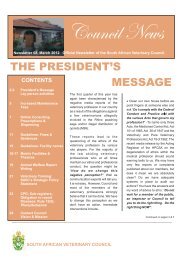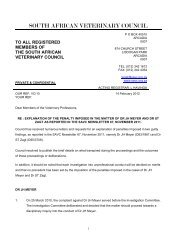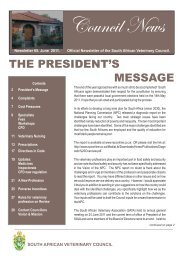Rabies Guide 2010.pdf - the South African Veterinary Council
Rabies Guide 2010.pdf - the South African Veterinary Council
Rabies Guide 2010.pdf - the South African Veterinary Council
You also want an ePaper? Increase the reach of your titles
YUMPU automatically turns print PDFs into web optimized ePapers that Google loves.
Shedding of virus in saliva usually occurs<br />
simultaneously with, or soon after, <strong>the</strong> appearance<br />
of clinical signs and progressive with death usually<br />
within 10 days in animals and five days or less<br />
of <strong>the</strong> onset of rabies symptoms in humans (J.D.<br />
Godlonton, personal communication).<br />
Following central nervous system infection, <strong>the</strong> virus<br />
is transported centrifugally along cranial nerves and<br />
along motor and sensory pathways as well as <strong>the</strong><br />
spinal cord. This results in <strong>the</strong> presence of viral<br />
particles in peripheral nerve tracts in many tissues,<br />
particularly those of <strong>the</strong> head. Therefore, a diagnosis<br />
of rabies may sometimes be possible by examination<br />
of skin sections, where antigen can be detected within<br />
nerve tracts, or corneal smears. 26,27<br />
<strong>Rabies</strong> virus has been detected in small quantities<br />
in several non-neural tissues, including corneal<br />
epi<strong>the</strong>lium and hair follicles at <strong>the</strong> base of <strong>the</strong> neck,<br />
although <strong>the</strong> replication of rabies virus is not usually<br />
pronounced in nonneural tissue o<strong>the</strong>r than <strong>the</strong><br />
salivary glands.<br />
In all mammalian species <strong>the</strong> host is not infectious<br />
for most of <strong>the</strong> incubation period. <strong>Rabies</strong> infection<br />
is fatal in all species and no species is known to have<br />
a carrier state where virus is shed in <strong>the</strong> absence of<br />
clinical signs or imminent clinical signs. Exceptional<br />
and rare cases of human survivors have been recorded<br />
in a handful of cases where <strong>the</strong> patients did receive<br />
some prophylaxis but had severe residual neurological<br />
sequelae. To date only one case of a human survivor<br />
has been recorded in a patient who did not have any<br />
history of prophylaxis. The reason for <strong>the</strong> patient’s<br />
recovery is still being investigated and disputed. 183<br />
Immunity<br />
The immune mechanism by which rabies virus<br />
is cleared from <strong>the</strong> host is not well understood.<br />
Protective immunity against rabies involves both<br />
B-cell (humoral) and various pathways of <strong>the</strong> T-cell<br />
response. 28 The effective humoral response is directed<br />
only against <strong>the</strong> glycoprotein envelope of <strong>the</strong> virus.<br />
O<strong>the</strong>r proteins do not play any role in generating<br />
neutralising antibodies. Cytotoxic T-cell responses are<br />
directed against <strong>the</strong> glycoprotein, nucleoprotein and<br />
phosphoprotein components of <strong>the</strong> virus. Where <strong>the</strong><br />
host has been successfully vaccinated, virions within<br />
a wound will be cleared mainly by <strong>the</strong> humoral<br />
immune system through neutralisation before <strong>the</strong>y<br />
gain entry into <strong>the</strong> nervous system.<br />
Once inside <strong>the</strong> neurons, virions are inaccessible<br />
to this immune pathway. This is <strong>the</strong> main reason<br />
for urgent initiation of post-exposure vaccination<br />
and passive immunoglobulin treatment. Additional<br />
cytolytic immune mechanisms may operate against<br />
intracellular virus. This may be <strong>the</strong> cause of <strong>the</strong><br />
characteristic paralytic signs seen when rabid animals<br />
are improperly vaccinated. Inoculation of rabies viruscontaining<br />
saliva into a wound does not normally<br />
induce a detectable immune response.<br />
Animal and human rabies vaccines consist of<br />
inactivated whole-virus antigens grown on a cell<br />
culture or neural tissue substrate and, in <strong>the</strong> case of<br />
more modern cell-culture vaccines, partially purified<br />
to remove unnecessary proteins. Generally, veterinary<br />
pre-exposure vaccination, while human vaccines,<br />
which are considerably more expensive to produce,<br />
are used post-exposure. Pre-exposure vaccination may<br />
be recommended in people at high risk. There are no<br />
records of human rabies cases that have occurred in<br />
people fully vaccinated according to World Health<br />
Organisation (WHO) recommendations.<br />
Post-exposure prophylaxis of humans, using<br />
vaccine and immunoglobulin according to WHO<br />
recommendations (page 39, table 10 and Fig 7. pg 41<br />
or Appendix 2), provides rapid and effective protection<br />
if administered soon after exposure. The most frequent<br />
causes of failure of post-exposure prophylaxis are<br />
delays in administering <strong>the</strong> first vaccine dose or<br />
immunoglobulin, failure to complete <strong>the</strong> vaccine<br />
course and failure of correct wound management.<br />
Infiltration of <strong>the</strong> wound with immunoglobulin does<br />
not interfere with stimulation of <strong>the</strong> immune system<br />
by vaccine, which is administered at a site distant<br />
from <strong>the</strong> wound.<br />
<strong>Rabies</strong> vaccine strains in current use protect<br />
against many, but not all, lyssavirus genotypes. 181<br />
Experimental models predict that vaccines based on<br />
<strong>the</strong>se current vaccines strains will protect against<br />
so-called phylogroup 1 lyssavirus (including rabies,<br />
Duvenhage, European bat lyssa- 1 and 2 and<br />
Australian bat lyssaviruses), but not viruses belonging<br />
29, 180-181<br />
to phylogroup 2 (Lagos and Mokola viruses).<br />
Fur<strong>the</strong>r evidence for <strong>the</strong> lack of protection against<br />
Mokola as well as Lagos bat virus are <strong>the</strong> discovery of<br />
17, 185<br />
infections in vaccinated cats and dogs.
















